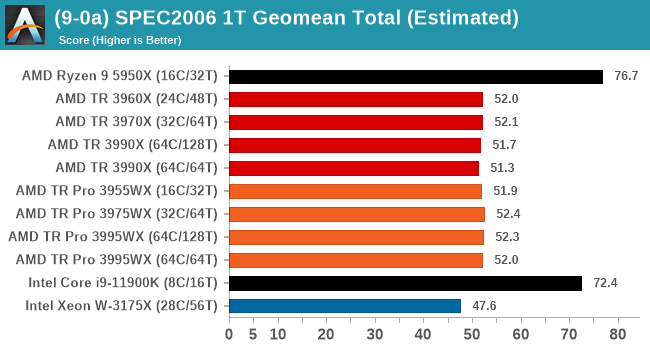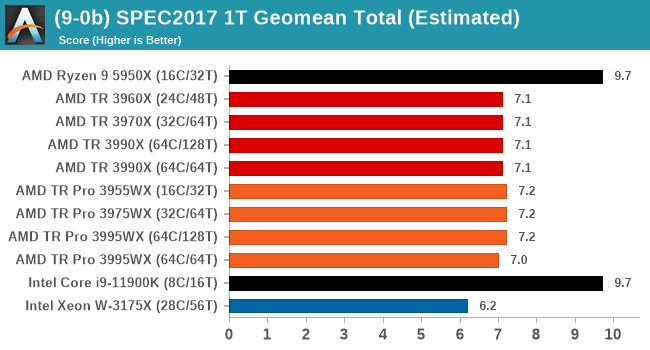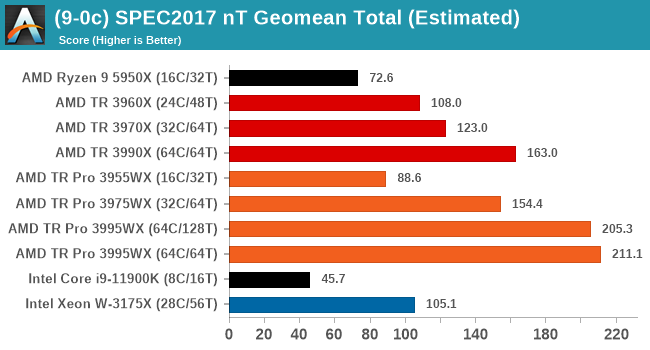AMD Threadripper Pro Review: An Upgrade Over Regular Threadripper?
by Dr. Ian Cutress on July 14, 2021 9:00 AM EST- Posted in
- CPUs
- AMD
- ThreadRipper
- Threadripper Pro
- 3995WX
CPU Tests: SPEC
SPEC2017 and SPEC2006 is a series of standardized tests used to probe the overall performance between different systems, different architectures, different microarchitectures, and setups. The code has to be compiled, and then the results can be submitted to an online database for comparison. It covers a range of integer and floating point workloads, and can be very optimized for each CPU, so it is important to check how the benchmarks are being compiled and run.
We run the tests in a harness built through Windows Subsystem for Linux, developed by our own Andrei Frumusanu. WSL has some odd quirks, with one test not running due to a WSL fixed stack size, but for like-for-like testing is good enough. SPEC2006 is deprecated in favor of 2017, but remains an interesting comparison point in our data. Because our scores aren’t official submissions, as per SPEC guidelines we have to declare them as internal estimates from our part.
For compilers, we use LLVM both for C/C++ and Fortan tests, and for Fortran we’re using the Flang compiler. The rationale of using LLVM over GCC is better cross-platform comparisons to platforms that have only have LLVM support and future articles where we’ll investigate this aspect more. We’re not considering closed-sourced compilers such as MSVC or ICC.
clang version 10.0.0-svn350067-1~exp1+0~20181226174230.701~1.gbp6019f2 (trunk)
-Ofast -fomit-frame-pointer
-march=x86-64
-mtune=core-avx2
-mfma -mavx -mavx2
Our compiler flags are straightforward, with basic –Ofast and relevant ISA switches to allow for AVX2 instructions. We decided to build our SPEC binaries on AVX2, which puts a limit on Haswell as how old we can go before the testing will fall over. This also means we don’t have AVX512 binaries, primarily because in order to get the best performance, the AVX-512 intrinsic should be packed by a proper expert, as with our AVX-512 benchmark. All of the major vendors, AMD, Intel, and Arm, all support the way in which we are testing SPEC.
To note, the requirements for the SPEC licence state that any benchmark results from SPEC have to be labelled ‘estimated’ until they are verified on the SPEC website as a meaningful representation of the expected performance. This is most often done by the big companies and OEMs to showcase performance to customers, however is quite over the top for what we do as reviewers.
For each of the SPEC targets we are doing, SPEC2006 rate-1, SPEC2017 rate-1, and SPEC2017 rate-N, rather than publish all the separate test data in our reviews, we are going to condense it down into a few interesting data points. The full per-test values are in our benchmark database.


Single thread is very much what we expected, with the consumer processors out in the lead and no real major differences between TR and TR Pro.

That changes when we move into full thread mode. The extra bandwidth of TR Pro is clear to see, even in the 32C/64T model. In this test we're using 128 GB of memory for all TR and TR Pro processors, and we're seeing a small bump when in 64C/64T mode, perhaps due to the increased memory cap/thread and memory bandwidth/thread as well. The 3990X 64C/128T run kept failing for an odd reason, so we do not have a score for that test.










98 Comments
View All Comments
mode_13h - Saturday, July 17, 2021 - link
Sometimes they do show it. I wonder why not, this time?One thing to note is how some of the same applications they benchmark in standalone tests are *also* included in SPEC17. So, those tests can get over-represented.
Blastdoor - Wednesday, July 14, 2021 - link
Re:"We are patiently waiting for AMD to launch Threadripper versions with Zen 3 – we hoped it would have been at Computex in June, but now we’re not sure exactly when."
Maybe it will happen when Intel offers something remotely competitive in this market? Or maybe when supply constraints ease and AMD can fully meet demand?
mode_13h - Wednesday, July 14, 2021 - link
Chagall (Threadripper 5000-series) is rumored to launch in August.Threska - Wednesday, July 14, 2021 - link
Long as AMD sticks to the same socket the platform should have longevity just like AM4.Bernecky - Wednesday, July 14, 2021 - link
Your "AMD Comparison" shows Threadripper DRAM as: 4×DDR4-3200.This is incorrect: I have a 3970X running on an ASUS ROG Zenith Extreme II Alpha, with
256GB: 8×DDR4-3600(OC slightly).
The Alpha no longer appears on the ASUS web site. Not sure what happened to it.
JMC2000 - Wednesday, July 14, 2021 - link
The "4xDDR-3200" is referencing 4 channels @ a non-overclocked speed of 3200; what you have is 8 DDR4 DIMMs in 4 channels.Railgun - Sunday, July 18, 2021 - link
Still here on the UK site.https://www.asus.com/uk/Motherboards-Components/Mo...
Oxford Guy - Wednesday, July 14, 2021 - link
‘The only downside to EPYC is that it can only be used in single socket systems, and the peak memory support is halved (from 4 TB to 2 TB).’Eh?
I assume you meant TR Pro. A big downside is that it’s Zen 2.
Thanny - Wednesday, July 14, 2021 - link
Ryzen and Threadripper support ECC memory just fine. It's only registered memory that isn't supported, which is why you can only get 128GB into a Ryzen platform and 256GB into a Threadripper platform (32GB is the largest unbuffered DIMM you can get).The motherboard must also support it, which not all Ryzen motherboards do. But all Threadripper boards support ECC. I'm using 128GB of unbuffered ECC right now with a 3960X.
willis936 - Thursday, July 15, 2021 - link
>Ryzen and Threadripper support ECC memory just fineA common misconception. Error reporting does not work with any AM4 chipset on non-pro AMD processors. Sure you have ECC, maybe. How do you know the soft error rate isn't massive?